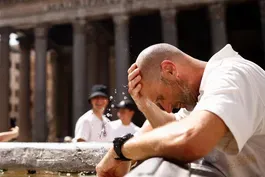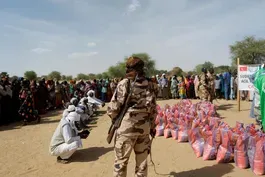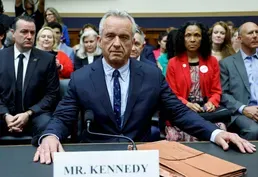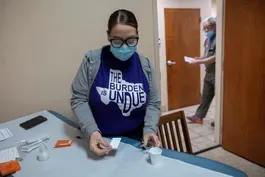
Why ACL injuries are more common in female athletes
Clip: 7/20/2023 | 8m 8sVideo has Closed Captions
Why ACL injuries are more common in female athletes than male counterparts
As the World Cup kicks off, many of the big names in women's soccer are notably absent from the international competition because of knee injuries, specifically ACL tears. It’s part of what some are calling an epidemic among female athletes from the professional level down to youth sports. Amna Nawaz reports from Los Angeles.
Problems with Closed Captions? Closed Captioning Feedback
Problems with Closed Captions? Closed Captioning Feedback
Major corporate funding for the PBS News Hour is provided by BDO, BNSF, Consumer Cellular, American Cruise Lines, and Raymond James. Funding for the PBS NewsHour Weekend is provided by...

Why ACL injuries are more common in female athletes
Clip: 7/20/2023 | 8m 8sVideo has Closed Captions
As the World Cup kicks off, many of the big names in women's soccer are notably absent from the international competition because of knee injuries, specifically ACL tears. It’s part of what some are calling an epidemic among female athletes from the professional level down to youth sports. Amna Nawaz reports from Los Angeles.
Problems with Closed Captions? Closed Captioning Feedback
How to Watch PBS News Hour
PBS News Hour is available to stream on pbs.org and the free PBS App, available on iPhone, Apple TV, Android TV, Android smartphones, Amazon Fire TV, Amazon Fire Tablet, Roku, Samsung Smart TV, and Vizio.
Providing Support for PBS.org
Learn Moreabout PBS online sponsorshipGEOFF BENNETT: As the World Cup kicks off, many of the big names in women's soccer are notably absent from the international competition because of knee injuries, namely ACL tears.
That includes us soccer's Catarina Macario and Christen Press, England's Leah Williamson and Beth Mead, and Netherlands striker Vivianne Miedema, and many more.
As Amna Nawaz reports from Los Angeles, it's part of what some are calling an epidemic among female athletes from the professional level all the way down to youth sports.
CASSIDY TSHIMBALANGA, Suffered Sports Injury: Soccer was my love, and it was my passion.
AMNA NAWAZ: In high school, Cassidy Tshimbalanga's dreams were on track.
She was a star forward on her team with plans to play in college and then hopefully the pros.
But that all changed in a single moment.
CASSIDY TSHIMBALANGA: It was a high school game against our rivals, Monte Vista.
And I was playing forward at the time.
And the ball bounced in front of my head.
AMNA NAWAZ: She was sandwiched between the goalie and a defender.
CASSIDY TSHIMBALANGA: I have no clue what's going on.
I just know I'm in excruciating pain.
AMNA NAWAZ: The diagnosis?
A torn anterior cruciate ligament, better known as the ACL.
One surgery and more than a year of rehab later, Tshimbalanga stepped back onto the field, this time for UCLA.
But before the season even starts, she tore the ACL in her other knee, another surgery, another year of rehab, another attempt to play, but the following year, another tear, followed by a fourth.
CASSIDY TSHIMBALANGA: Each time I tore my ACL, it's like my dreams were getting farther and farther from me.
AMNA NAWAZ: Did you see other players around you suffering the same injury over your college career?
CASSIDY TSHIMBALANGA: A lot of other players, especially during my time at UCLA.
DR. KRISTOFER JONES, Orthopedic Surgeon: We have seen an explosion of ACL injuries in young women all the way from 10 years of age up to their teens.
AMNA NAWAZ: As an orthopedic surgeon and team doctor for UCLA and the Los Angeles Lakers, Dr. Kristofer Jones sees multiple ACL tears every week.
DR. KRISTOFER JONES: It's not uncommon to some of these girls so already come in at the high school level, to our collegiate team at UCLA and already have had an ACL reconstruction.
AMNA NAWAZ: Girls who play multiple sports in high school have about a 10 percent chance of an ACL injury.
The highest-risk sports are soccer, basketball, and lacrosse, sports where athletes tend to cut and pivot.
And with more girls and women playing sports than ever before, doctors are seeing more injuries.
But female athletes are about four times more likely to experience an ACL tear than their male counterparts.
That disparity is sparking outcry from elite athletes, including U.S. forward Christen Press, one of several players who won't be at this year's World Cup because of ACL tears.
CHRISTEN PRESS, U.S. Women's Soccer Player: If this happened on the men's side, we would have immediately seen a reaction of, how are we going to solve this and figure this out?
AMNA NAWAZ: U.S. soccer star Megan Rapinoe has had three ACL tears over her career.
MEGAN RAPINOE, U.S. Women's Soccer Player: I kind of think that a lot of the injuries that we're seeing is due to the increase in schedule.
And, obviously, we're playing a lot more games, we're traveling a lot more with like a fraction of the resources that we really need to have to perform at the highest level.
AMNA NAWAZ: I mean, what will it take?
We hear from the highest levels of play some people saying if this was happening on the men's side, if we saw these numbers, this would have been solved by now.
Do you agree with that?
DR. KRISTOFER JONES: Women definitely need better resources at the team level to try and dedicate to the injury prevention programs.
I think we certainly are getting better at putting our finger on some of the risk factors that we can fix.
AMNA NAWAZ: Some of the risk factors have to do with anatomy.
DR. KRISTOFER JONES: Here, you can see the ACL.
AMNA NAWAZ: The ACL is a ligament that helps stabilize the knee.
One wrong move, and it can tear.
DR. KRISTOFER JONES: And this is the end of the ACL -- the ACL ligament, which is torn off the top of the femur.
AMNA NAWAZ: Researchers have found that less muscle strength in the hamstrings, glutes and core and even the size of the notch where the ACL sits likely make women more prone to ACL tears.
Others are exploring whether hormones could play a role.
HOLLY SILVERS-GRANELLI, Velocity Sports PT: The problem with all of those risk factors is, there's very little we can do about them.
AMNA NAWAZ: Physical therapist Holly Silvers-Granelli and one of her colleagues designed a soccer warmup program that focuses on what athletes can control.
HOLLY SILVERS-GRANELLI: One of the major mechanisms for ACL injury happens during change of direction, so cutting, pivoting and decelerating.
So we implemented all of those types of movements into the program, so that athletes could get comfortable with them.
AMNA NAWAZ: The exercises help athletes develop muscle memory to move more safely and strengthens parts of their body that support the ACL.
The result?
A reduction in ACL injuries by up to 88 percent.
So why are ACL tears still so pervasive?
HOLLY SILVERS-GRANELLI: Part of the problem is that the compliance or the adherence to these types of programs is poor.
AMNA NAWAZ: Preventing ACL injuries is personal for Ally Mueller, who coaches the Predators girls lacrosse club in New York.
She tore her ACL in college, but says implementing injury prevention hasn't always been easy.
ALLY MUELLER, Coach, Predators Girls Lacrosse Club: In the past, it's been a time constraint.
And it's - - there's so many other things within a practice for whatever sport you're playing that you have to focus on with a limited time period.
AMNA NAWAZ: But she says there's growing awareness about the importance of injury prevention and how it can improve performance.
ALLY MUELLER: And I think people are finally seeing that it really is a problem, because it's too late.
If you don't put in the groundwork early on, then you can have these injuries, and it's really draining mentally, physically and it's something that's hard to come back from.
AMNA NAWAZ: She and her team are starting to use a newly launched app from the New York-based Hospital for Special Surgery that shows athletes exercises they can do to help prevent injury on their own time, and allows coaches to track their progress.
Its effectiveness is still being tested.
But it's the kind of thing Cassidy Tshimbalanga wishes she had before her injury.
CASSIDY TSHIMBALANGA: No one really mentioned injury prevention, not until I got to around my second tear.
But, then again, it's more of a reaction, rather than being proactive.
AMNA NAWAZ: For now, ACL injuries are still very common.
So experts say athletes and medical professionals have to think about long-term health risks, including early arthritis.
DR. KRISTOFER JONES: With these girls, what we need to do is do a better job of counseling them.
If they're on their third or fourth ACL, we just -- we need to sit them down and say, look, this may not necessarily be the sport for you.
AMNA NAWAZ: That has to be really hard to hear.
DR. KRISTOFER JONES: Yes.
I mean, for some of these girls and young people, it's their identity.
AMNA NAWAZ: It was a decision Tshimbalanga had to make.
After her fourth ACL tear, she stopped playing soccer.
Soon after, she watched from her apartment as her old college team won the national championship.
CASSIDY TSHIMBALANGA: I was very, very happy for them and just seeing their face and seeing my friends up on the TV.
It was amazing.
But there's always that kind of deep, lingering sadness about what life could have been like for me.
AMNA NAWAZ: To work for something for so long, for 10 years, to reach that point, and then have your career unfold the way that it did, I just wonder how you look back on it.
CASSIDY TSHIMBALANGA: I learned a lot of things about myself and I'm using all of those skills to create a success story for myself.
And part of me thinks that everything that I have learned through that whole process and this new transition of change might be more powerful than ultimately what I would have been playing soccer.
AMNA NAWAZ: She's now on track to go to law school with a new perspective on life and a new dream to fulfill.
Heat waves break records and disrupt life across world
Video has Closed Captions
Punishing heat waves break records and disrupt life across much of the world (9m 23s)
Millions flee homes in Sudan amid reports of war crimes
Video has Closed Captions
Millions flee homes in Sudan amid reports of widespread war crimes (6m 21s)
RFK Jr. comments spreading misinformation draw scrutiny
Video has Closed Captions
RFK Jr. appears before Congress as his comments spreading misinformation draw scrutiny (10m 43s)
Stanford president resigns after report on flawed research
Video has Closed Captions
Student journalist discusses reporting that led to Stanford president's resignation (5m 24s)
Texas women testify in lawsuit against abortion restrictions
Video has Closed Captions
Texas women testify in lawsuit claiming abortion restrictions put their lives in jeopardy (7m 15s)
Providing Support for PBS.org
Learn Moreabout PBS online sponsorshipSupport for PBS provided by:
Major corporate funding for the PBS News Hour is provided by BDO, BNSF, Consumer Cellular, American Cruise Lines, and Raymond James. Funding for the PBS NewsHour Weekend is provided by...
















